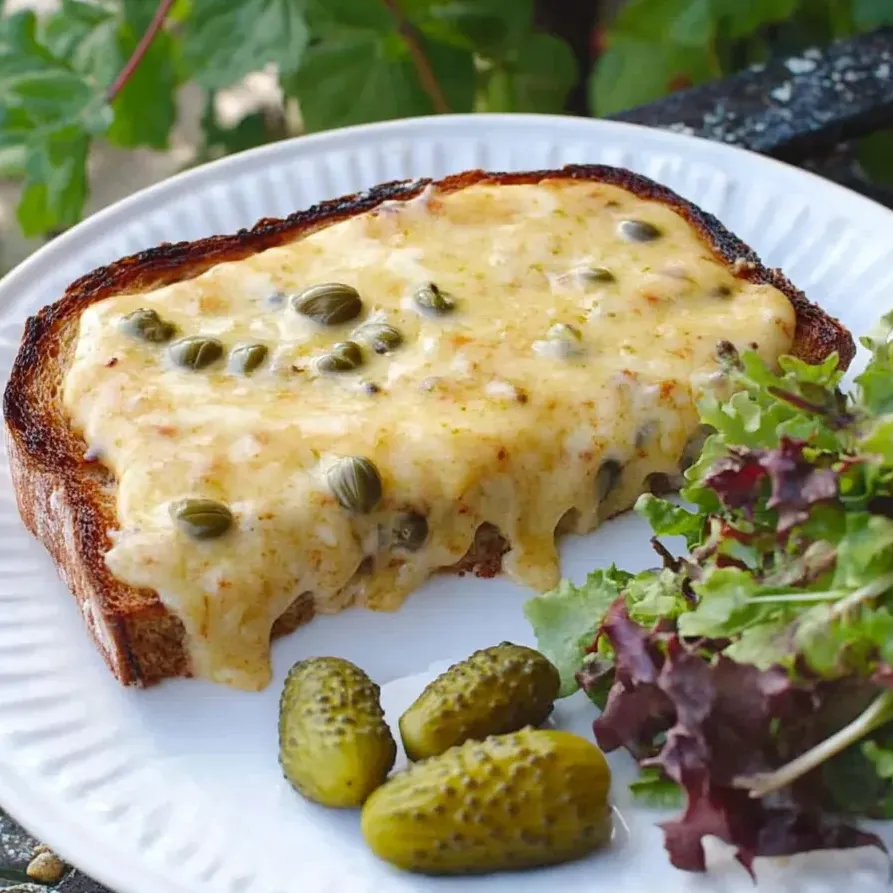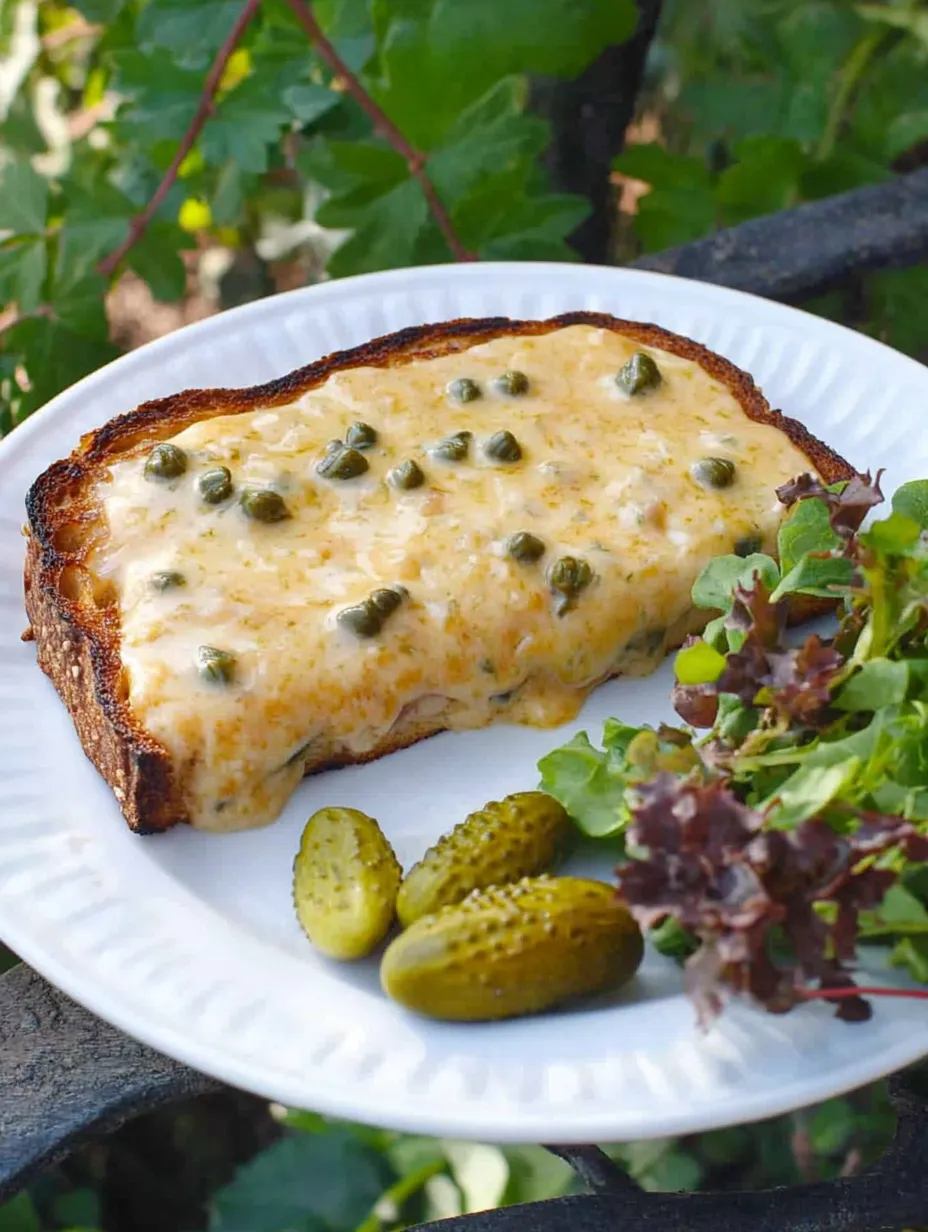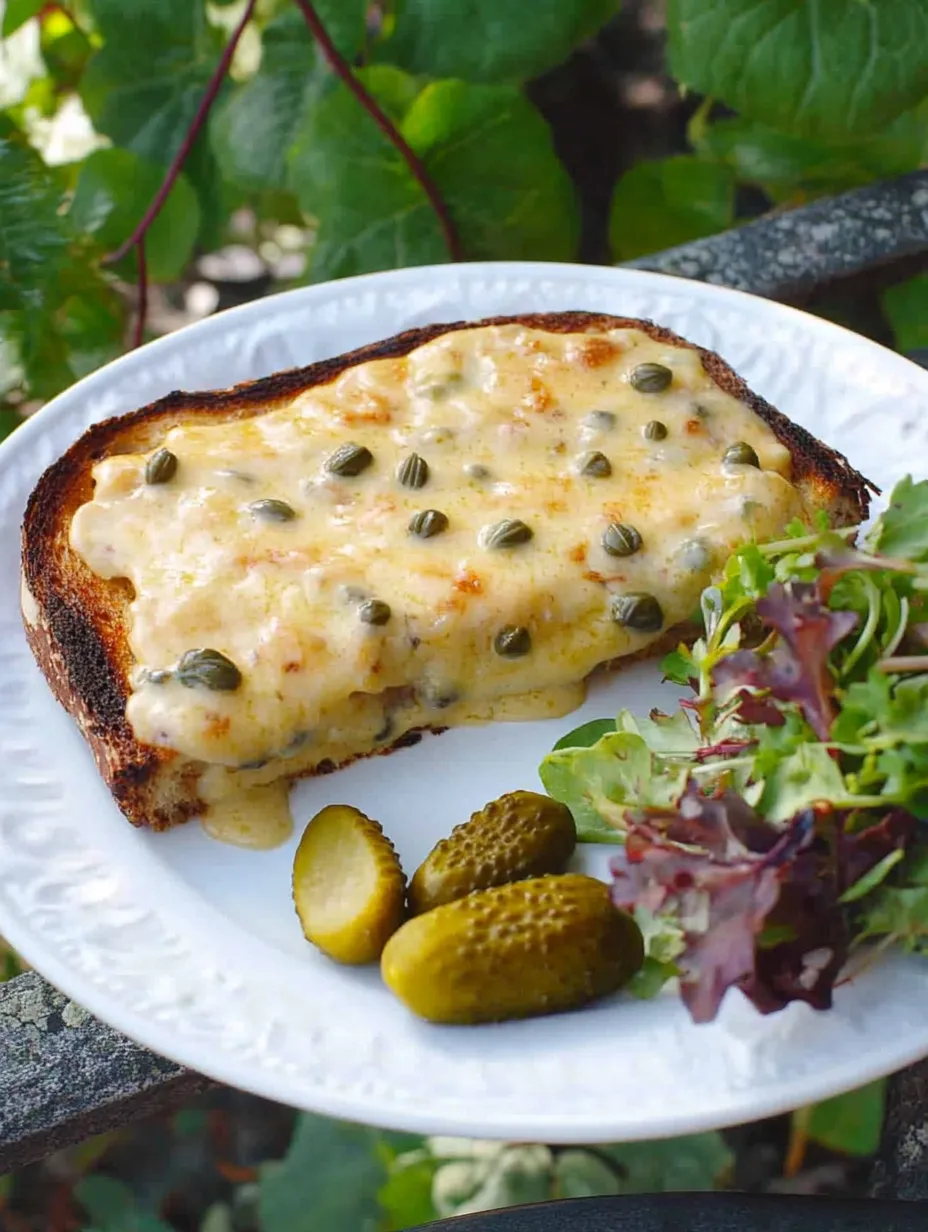 Pin it
Pin it
Emerald Melt: Classic Irish Rarebit. This Irish Rarebit recipe offers a remarkably quick yet deeply satisfying open-faced sandwich, transforming humble ingredients into a luxurious and flavorful experience. Imagine perfectly toasted bread generously smothered with a velvety blanket of melted Irish cheddar, its richness beautifully punctuated by the tangy zest of chopped gherkins and a subtle, warming hint of mustard. This isn't just cheese on toast; it's a comforting culinary embrace, ideal for a swift breakfast, a comforting lunch, or a light and flavorful dinner.
I first encountered Irish Rarebit during a chilly visit to the Emerald Isle, and it was an instant revelation. The warmth of the melted cheese, the subtle tang, and the satisfying crunch of the gherkins were a perfect antidote to the cold. It’s a dish that evokes a sense of comforting simplicity and robust flavor, a true testament to the beauty of well-chosen ingredients.
Essential Ingredients
- Unsalted Butter: Forms the luscious base of the cheese sauce, adding richness and a smooth, velvety texture. Using unsalted butter allows you to precisely control the overall saltiness of the dish, especially considering the inherent saltiness of the cheddar.
- Whole Milk: Contributes to the creamy consistency of the cheese sauce, ensuring it's smooth and easily spreadable over the toasted bread. The fat content in whole milk helps create a richer mouthfeel.
- Irish Cheddar Cheese (Kerrygold Dubliner or other melty cheese): The heart and soul of this dish. Opt for a good quality Irish cheddar, such as Kerrygold Dubliner, known for its rich flavor and excellent melting properties. Ensure it's freshly grated for the smoothest possible sauce.
- White Vinegar: A seemingly small addition, but it plays a vital role in cutting through the richness of the cheese sauce, adding a subtle tang that brightens the overall flavor profile and prevents it from feeling too heavy.
- English Mustard (or Dijon): Provides a distinct warmth and complexity to the cheese sauce. English mustard offers a sharper, more pungent flavor, while Dijon mustard lends a more nuanced, slightly smoother heat. Choose according to your preference.
- Freshly Grated Black Pepper: Adds a subtle warmth and a hint of spice that complements the richness of the cheese and the tang of the mustard and vinegar. Freshly grated pepper offers a more aromatic and impactful flavor than pre-ground.
- Gherkins (or Cornichons, Chopped): These small, tangy pickles provide a delightful textural contrast and a burst of acidity that beautifully cuts through the richness of the melted cheese. Finely chop them to ensure they are evenly distributed throughout the rarebit.
- Good Quality Bread (Toasted): The sturdy foundation upon which the cheesy masterpiece rests. Choose a good quality bread with a robust texture that can stand up to the rich topping. Sourdough, artisan white bread, or a hearty whole grain are excellent choices. Toasting one side provides a crispy base while allowing the other side to absorb some of the flavorful cheese sauce.
 Pin it
Pin it
Creating the Emerald Melt
- The Foundation of Flavor:
- In a small to medium saucepan, melt the unsalted butter over low heat. Gentle heat is key here to prevent the butter from browning prematurely and to ensure a smooth, even melting process.
- Building the Creaminess:
- Once the butter is fully melted, pour in the milk and stir to combine. Maintain the low heat throughout this process.
- The Star Attraction:
- Gradually add the freshly grated Irish cheddar cheese to the butter and milk mixture, stirring continuously with a whisk or a wooden spoon. Continue stirring until the cheese is completely melted and the sauce is smooth, velvety, and homogenous. The low heat is crucial for achieving a smooth, lump-free sauce.
- Enhancing the Flavor Profile:
- Once the cheese sauce is smooth, stir in the white vinegar, English mustard (or Dijon), and freshly grated black pepper. Mix thoroughly to ensure all the flavors are evenly incorporated into the luscious sauce. Finally, fold in the finely chopped gherkins (or cornichons), distributing them evenly throughout the cheesy mixture.
- Preparing the Canvas:
- While the cheese sauce is gently simmering on low heat, preheat your broiler to a medium-high setting. Take your slices of good quality bread and toast them on one side under the broiler until they are lightly golden and crisp. Toasting only one side is a traditional technique that provides a sturdy, crispy base while allowing the untoasted side to absorb some of the flavorful cheese sauce.
- The Crowning Glory:
- Once the bread is toasted on one side, carefully remove it from the broiler and turn the slices over so that the untoasted side is facing upwards. Divide the warm cheese mixture evenly among the toasted bread slices, ensuring each slice is generously covered with the flavorful melted cheese, gherkins, and mustard.
- Achieving Golden Perfection:
- Place the cheese-topped toast back under the preheated broiler. Keep a close eye on them, as broilers can work quickly. Broil until the cheese mixture is bubbly, golden brown, and slightly crispy in places. This should take just a few minutes.
- The Final Flourish:
- Once the Irish Rarebit reaches golden perfection, carefully remove it from the broiler. Serve immediately while it is still hot and the cheese is gloriously melted and bubbly. You can serve it with extra chopped gherkins on the side for those who desire an extra burst of tang, and a simple green salad can provide a refreshing counterpoint to the richness of the rarebit.
My own experiments with Irish Rarebit have led me to occasionally add a small splash of Irish whiskey to the cheese sauce instead of the vinegar for a deeper, more complex flavor. I've also found that a poached egg nestled on top of the finished rarebit transforms it into an even more substantial and decadent meal. On occasion, particularly when serving it as a more casual supper, I'll stir in a little bit of Irish stout or another dark beer into the cheese sauce for a malty undertone that pairs wonderfully with the cheddar.
Variations to Explore
- Cheese Adventures: Feel free to experiment with other flavorful, melty cheeses such as aged Gouda for a nutty depth or a smoked cheese for an intriguing smoky note.
- A Wee Dram: For a more sophisticated twist, try adding a tablespoon of Irish whiskey to the cheese sauce instead of the white vinegar. The alcohol will cook off, leaving behind a subtle, warming flavor.
- The Regal Addition: Elevate your Irish Rarebit to a truly decadent experience by carefully placing a perfectly poached egg on top of the cheesy toast just before serving. The runny yolk will mingle beautifully with the rich sauce.
- A Pint's Worth of Flavor: For a more traditional and robust flavor, stir a few tablespoons of your favorite Irish stout or another dark beer into the cheese sauce along with the other flavorings. The beer adds a malty depth that complements the cheddar wonderfully.
Perfect Pairings
Irish Rarebit is a versatile dish that pairs well with a variety of accompaniments. A simple green salad dressed with a light vinaigrette provides a refreshing contrast to the richness of the cheese. A warm bowl of classic tomato soup is another comforting and classic pairing. For a more traditional pub-style experience, serve it alongside some tangy pickled vegetables or a side of crispy potato wedges.
Make-Ahead Considerations
While Irish Rarebit is truly at its best when served immediately, the cheese sauce itself can be made ahead of time. Prepare the sauce according to the recipe, then allow it to cool slightly before storing it in an airtight container in the refrigerator for up to 2 days. When you're ready to assemble the rarebit, gently reheat the cheese sauce over low heat, stirring occasionally, until it is smooth and creamy again. You may need to add a tiny splash of milk to restore its original consistency.
 Pin it
Pin it
Frequently Asked Questions
- The Distinction: While both are variations of cheese on toast, Welsh Rarebit often incorporates beer or ale into the cheese sauce, whereas Irish Rarebit traditionally uses milk and sometimes whiskey. The types of cheese used can also vary.
- Serving Suggestions Beyond the Plate: Beyond salads and soups, consider serving Irish Rarebit as part of a light brunch spread alongside other savory items like sausages or grilled tomatoes.
- Preparing in Advance: As mentioned, the cheese sauce can be made ahead, but the assembled rarebit is best enjoyed immediately to prevent the toast from becoming soggy.
- Bread Choices Matter: While the recipe suggests a few excellent options, feel free to experiment with other sturdy breads you enjoy. The key is to choose a bread that can hold up to the rich topping.
- No Broiler, No Problem: If you don't have a broiler, you can achieve a similar result by using a high-heat oven (around 450°F or 230°C) or even a toaster oven. Keep a close watch to prevent burning.
This recipe for Irish Rarebit provides a comprehensive guide to creating a truly comforting and flavorful dish. Its simplicity belies its deliciousness, making it a perfect choice for a quick yet satisfying meal. Enjoy the emerald melt!
Frequently Asked Questions
- → What's the difference between this Irish toast and traditional Welsh Rarebit?
- The main difference is the cheese - this recipe uses Irish cheddar (like Kerrygold Dubliner) instead of the traditional Welsh cheese. Traditional Welsh Rarebit often includes beer or ale and sometimes Worcester sauce, while this Irish version simplifies the recipe and adds chopped gherkins for a tangy twist. The preparation method is similar, creating a cheese sauce that's spread on toast and broiled until bubbly.
- → Can I make the cheese sauce ahead of time?
- Yes! You can prepare the cheese sauce up to 2 days ahead and store it in an airtight container in the refrigerator. When ready to use, gently reheat it in a saucepan over low heat, adding a splash of milk if needed to reach the original consistency. Then proceed with spreading it on toast and broiling as directed in the recipe.
- → What bread works best for this recipe?
- A good quality, sturdy bread that can hold up to the cheese sauce works best. Sourdough, country loaf, or a hearty whole grain bread are excellent choices. Avoid very soft sandwich breads which may become too soggy. For the best results, make sure to toast the bread before adding the cheese mixture so it maintains some structure.
- → What can I serve with this Cheesy Irish Toast?
- This dish pairs beautifully with a simple green salad dressed with a light vinaigrette to balance the richness. For brunch, serve it alongside some crispy bacon or grilled tomatoes. For a heartier meal, a bowl of tomato soup makes a perfect companion. A crisp apple or pear on the side also provides a nice contrast to the rich, savory flavors.
- → Can I make this recipe vegetarian or gluten-free?
- This recipe is already vegetarian! To make it gluten-free, simply use your favorite gluten-free bread and check that your mustard is gluten-free (most are, but it's always good to verify). The rest of the ingredients are naturally gluten-free. Just be mindful that some pre-grated cheeses may contain anti-caking agents that contain gluten, so it's safest to grate your own cheese from a block.
